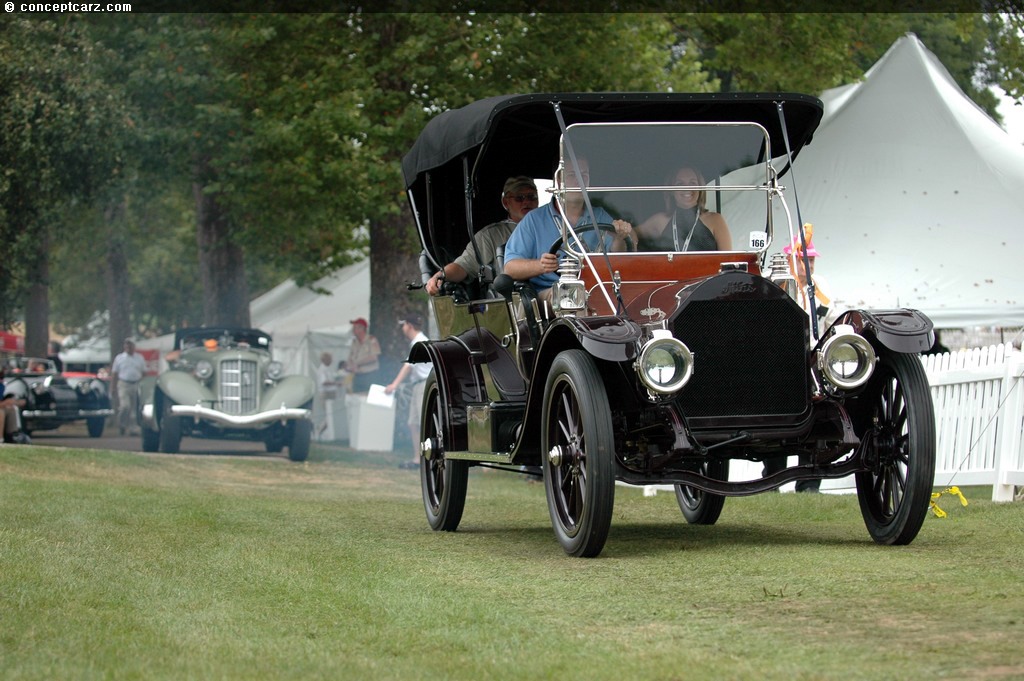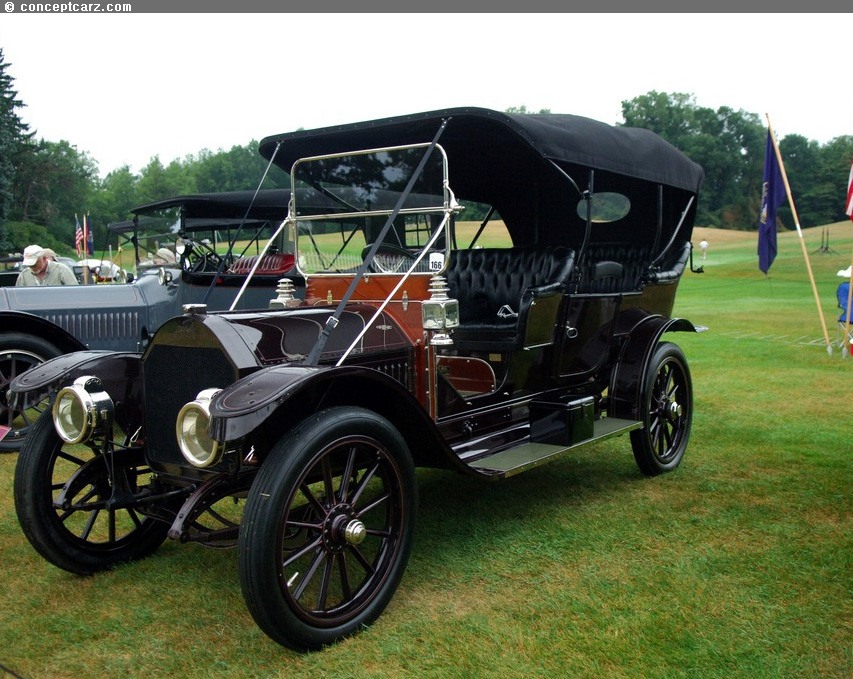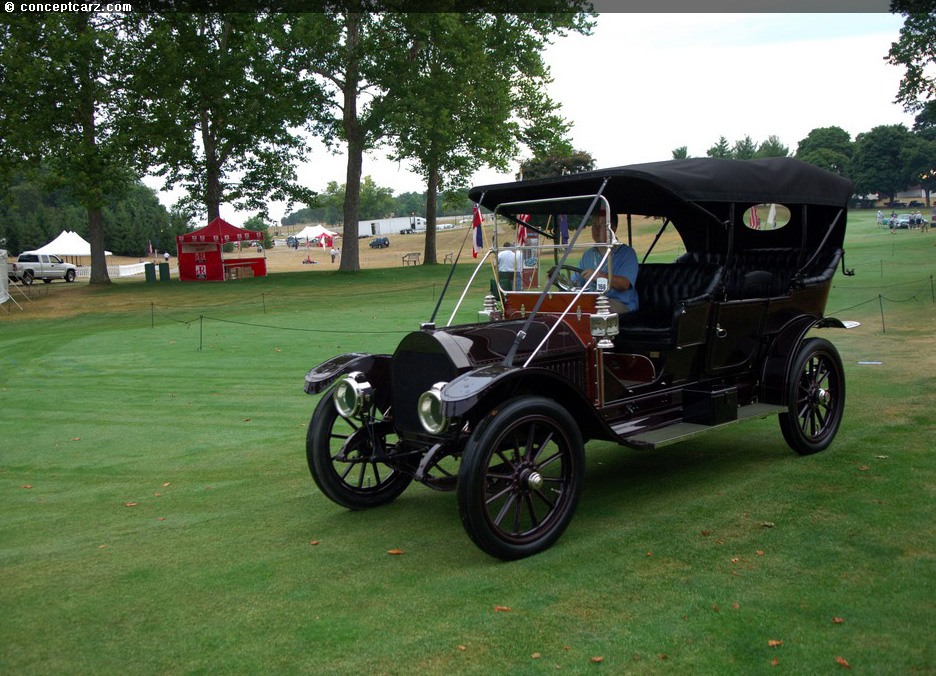As the nineteenth century drew to a close, the fledgling automobile industry was coming into its own. The great automotive pioneers were beginning to emerge and Harry A. Knox was amongst them. 
Tourer
Chassis #: 1084H
View info and history
Auction entries : 2The Knox Automobile Company was founded in Springfield, Massachusetts in 1897 and quickly established itself as a builder of quality air-cooled vehicles. But like Olds, the Stanley brothers, and others, Knox was constantly in conflict with his company's financial backers. As a result, he left the company bearing his name to establish the Knox Motor Truck Company in 1905, also in Springfield. His first two-ton truck was called the Atlas. He soon found himself in court over the re-use of his name for the company. Like Ransom E. Olds, Knox was forbidden to use his own name. Thus, in 1907 the company was transformed into the Atlas Motor Car Company.That same year Knox began building under license two-stroke engines manufactured by the Sunset Automobile Company of San Francisco. Sunset at first had been reluctant, but the 1906 earthquake had all but destroyed the factory and thus Knox's cash was desperately needed to rebuild it. 
Tourer
Chassis #: 1084H
View info and history
Auction entries : 2The two-stroke, two-cylinder, and four-cylinder Atlas models were marketed as automobiles with the 'Perfect Two Cycle Engine.' Atlas models grew to become popular, especially the delivery van and taxi cab models. Knox also developed a three-cylinder version of the engine.In 1909 Harry Know entered an Atlas in the popular Vanderbilt race. Knox piloted his Atlas to a respectable fifth place. The resulting publicity saw production increase, but this brief success ended in 1911. By that time the two-cycle engines were uncompetitive and the lack of a suitable replacement resulted in Atlas' demise. Knox reorganized his company to produce the Atlas-Knight. These sleeve-valve-powered five and seven-passenger touring cars were built from 1911 to 1913. Still, in its day, many saw credence in the Atlas claim that their engines were, '…the simplest, most indestructible engine built.' Without valves and designed with only five moving parts, Atlas was very innovative for its time. The Atlas's novelty lay in its use of an offset crankshaft and none of the troublesome parts such as camshafts, valve seals, bearings, rocker arms, etc.
Tourer
Chassis #: 1084H
View info and history
Auction entries : 2In 1910 Atlas built the most stylish and luxurious car in the company's history when it introduced the 60 horsepower Model H as a five or seven-passenger touring car.Thought to be the only Atlas Model H in existence today, this Model H Touring was discovered as part of a Colorado enthusiast's collection by employees of the Harrah Auto Collection in 1964. At the time it was related that the Atlas was totally original and virtually complete. Harrah purchased the Atlas and eventually had it totally restored to the highest of Harrah's standards. The Atlas received the 'Gold Star' trademark restoration, which meant this Model H was restored mechanically and cosmetically so it would, '…perform and look as it had when it was new.' Since it was sold from the Harrah collection in 1987, this Atlas has continued to be well maintained by its subsequent owners. The very handsome 1910 right-hand-drive Touring was painted in classic Bordeaux Red with an interior completely outfitted in traditional tufted, black buttoned leather. It appears to be almost as fresh as it did when restored well over twenty-five years ago. Following its restoration it was driven sparingly, and while in the ownership of noted collector Mr. William Lassiter of West Palm Beach, Florida, the Stewart Speedometer then showed only 200 miles. At the time, this author also had the pleasure of driving the Atlas and was impressed to note that its four-cylinder, 60-horsepower engine provided ample power for the handsome Touring car to accelerate and cruise with ease.
Tourer
Chassis #: 1084H
View info and history
Auction entries : 2The plethora of nickeled brass (which is correct from new as illustrated in original factory brochures), including its large Gray and Davis headlamps, side lamps and tail lamp remain in excellent condition with a fine luster. Under the hood, the four-cylinder engine is fully detailed and painted as when new. Its black cloth top shows minimal wear commensurate with the rest of the Atlas.Most recently, the Atlas was shown at the 2007 Meadow Brook Hall Concours d'Elegance where it was awarded 'The Debut Award', which is given to the motor car deemed most significant on the field in its first showing. We understand that prior to its Meadow Brook debut, the Atlas has actually never been shown. This will certainly allow the car's next owner the privilege and distinction of showing the Atlas with pride on many AACA and Brass Era events including the Glidden Tour. Additionally, the Atlas actually made the trip to Meadow Brook from its Michigan-based collection and back three separate times, certainly a positive indication of its mechanical and operating condition. The current owner's restorers attest that the Atlas runs perfectly and will delight its next owners with further use, especially for a car that was restored over 25 years ago. Included in the sale of the Atlas is a large dossier with photos and information on the model as well. With just a mild patina, this Atlas Touring can still be shown with pride and will be invited to many national Concours events. Being a unique example with exceptional provenance, this 1910 Atlas Model H Tourer is certainly for the most discriminating of collectors of fine American horseless carriages only.Source - RM Auctions

Tourer
Chassis #: 1084H
View info and history
Auction entries : 2

Tourer
Chassis #: 1084H
View info and history
Auction entries : 2

Tourer
Chassis #: 1084H
View info and history
Auction entries : 2

Tourer
Chassis #: 1084H
View info and history
Auction entries : 2
Harry A. Knox founded the Knox Automobile Company in Springfield, Massachusetts in 1897. During the early years of production, the company prospered as its air-cooled vehicles were known for their quality and durability. Difficulties and disagreements with his financial backers had Harry Knox leaving the company a few years after its inception. In 1905 he formed the Knox Motor Truck Company, also based in Springfield. The management of the Knox Automobile Company felt did not agree with the name of the new truck company, so Harry Knox soon found himself being sued. Just like Ransom E. Olds, Knox was forbidden to use his own name. In 1907 he chose the name Atlas Motor Car Company after his first two-ton truck called the Atlas. That same year he acquired a license with the Sunset Automobile Company of San Francisco to use their two-stroke engines. 
Tourer
Chassis #: 1084H
View info and history
Auction entries : 2The Atlas models were promoted as the 'Perfect Two Cycle Engine.' They came in two-stroke, two-cylinder and four-cylinder versions. Their product soon became popular, especially the taxi cab and delivery vans. Racing and endurance challenges were monumental resources for selling vehicles in the early 1900s. A win on Sunday meant great sales on Monday. Harry entered and piloted an Atlas vehicle in the 1909 Vanderbilt race. The race was very popular and very competitive. When Harry crossed the line in fifth place, the public acknowledged this accomplishment and sales began to increase. This success would be rather brief, as the lifespan of the competitiveness of the Sunset engines, both on the racing circuit and in production, soon faded. A suitable replacement could not be found which spelled the demise of the company. Knox reorganized the company to produce the Atlas-Knight. These vehicles, offered in a five and seven-passenger touring cars, were powered by sleeve-valve engines. The sleeve-valve engine was a mechanical masterpiece that had no valves and only five moving parts. It had an offset crankshaft and lacked the problematic parts such as camshafts, valve seals, bearings, and rocker arms. Production lasted from 1911 to 1913.
by Daniel Vaughan | Dec 2007

Tourer
Chassis #: 1084H
View info and history
Auction entries : 2
by Daniel Vaughan | Dec 2007
Similarly Priced Vehicles
1910 Atlas Model H Vehicle Profiles
Recent Vehicle Additions
Performance and Specification Comparison
Price Comparison
Related Automotive News

Brass Era Thomases Fly Past Estimates At Bonhams' White Glove Sale
Two Generations Collection 100 Sold in Newport
A pair of All-American Brass Era Thomas motor cars flew past their estimates, together achieving more than a million dollars, in Bonhams white glove Two Generations Collection...

Rare Barnfind Mercedes-Benz and Concours-Restorations Parade at Bonhams Scottsdale Auction
A rare and special barnfind Mercedes-Benz – surely one of the last unrestored 300S Roadsters – will line up with a parade of concours-standard restorations at The Scottsdale Auction, Bonhams motor cars season-opener staged at the Westin Kierland Resort,...

RM Auctions to Present The Merrick Auto Museum Collection at 13th Annual Hershey Sale
OVER 100 BRASS ERA CARS AND SELECTION OF MEMORABILIA OFFERED ENTIRELY WITHOUT RESERVE
RM Auctions set to offer the Merrick Auto Museum Collection at Hershey auction, 10-11 October in Pennsylvania
Offered entirely without reserve, the multi...

Premier To Make Its Premiere
Pioneering Indianapolis motor manufacturer makes its first ever appearance on Veteran Car Run
Roll out the red carpet this years Bonhams London to Brighton Veteran Car Run supported by Hiscox will feature another premiere… and, appropriately, this...

1960 FERRARI 400 SUPERAMERICA SWB CABRIOLET HEADLINES STUNNING LIST OF EUROPEAN SPORTS-TOURING CARS AT RM'S AMELIA ISLAND SALE
RM Auctions announces additional highlights for its Amelia Island, Florida sale, March 14
Recent entries led by a 1960 Ferrari 400 Superamerica SWB Cabriolet, one of the most valuable automobiles ever offered during the Amelia Island weekend
Th...



















